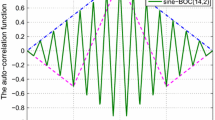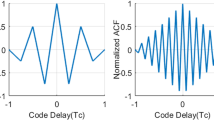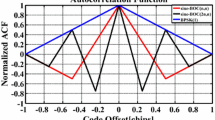Abstract
Binary offset carrier (BOC) modulated signal has been widely employed in modern global navigation satellite system (GNSS). However, the multiple peaks auto-correlation function of BOC signal leads to tracking ambiguity problem. For high-order BOC signal, the above problem becomes more severe. We propose an unambiguous tracking method based on combined correlation functions for sine-BOC signal. The main feature of this technique is that two new local reference waveforms are used. Based on the cross-correlation functions between the BOC signal and these two local reference waveforms, unambiguous combined correlation functions without any main positive side-peaks are generated. To achieve unambiguous tracking for sine-BOC signal, we present two non-coherent discriminator functions, denoted as V 1 and V 2. The theoretical expressions of code tracking error in thermal noise are derived. Then, the impact of thermal noise and multipath is analyzed with the help of numerical simulations. Results show that V 1 is easier to implement and has relatively better multipath mitigation performance at the expense of some performance degradation in code tracking error. V 2 has better code tracking accuracy and provides the most robust code tracking process for high-order sine-BOC signal, but two additional complex correlators are required.















Similar content being viewed by others
References
Anantharamu PB, Borio D, Lachapelle G (2009) Pre-filtering, side-peak rejection and mapping: several solutions for unambiguous BOC Tracking. In: Proceedings of ION GNSS 2009, Institute of Navigation, Savannah, GA, pp 3142–3155
Anantharamu PB, Borio D, Lachapelle G (2011) Sub-carrier shaping for BOC modulated GNSS signals. EURASIP J Adv Signal Process 133:1–18
Barker BC, Betz JW, Clark JE, Correia JT, Gillis JT, Lazar S, Rehborn KA, Straton JR (2000) Overview of the GPS M code signal. In: Proceedings of ION NTM 2000, Institute of Navigation, Anaheim, CA, pp 542–549
Betz JW (1999) The offset carrier modulation for GPS modernization. In: Proceedings of ION NTM 1999, Institute of Navigation, San Diego, CA, pp 639–648
Betz JW (2002) Binary offset carrier modulations for radionavigation. Navigation 48(4):227–246
Blunt P, Weiler R, Hodgart S, Unwin M (2007) Demonstration of BOC(15, 2.5) acquisition and tracking with a prototype hardware receiver. In: Proceedings of ENC-GNSS, Geneva, Switzerland, pp 1–11
Fine P, Wilson W (1999) Tracking algorithm for GPS offset carrier signals. In: Proceeding of ION NTM 1999, Institute of Navigation, San Diego, CA, pp 671–676
Garin L (2005) The ‘‘Shaping Correlator’’, Novel multipath mitigation technique applicable to Galileo BOC(1,1) modulation waveforms in high volume markets. In: Proceedings of ENC-GNSS, Munich, Germany, pp 1–16
Hodgart MS, Blunt PD (2007) Dual estimate receiver of binary offset carrier modulated signals for global navigation satellite systems. Electron Lett 43(16):877–878
Hodgart MS, Blunt PD, Unwin M (2007) The optimal dual estimate solution for robust tracking of binary offset carrier (BOC) modulation. In: Proceeding of ION GNSS 2007, Institute of Navigation, Fort Worth, TX, pp 1017–1027
Julien O, Cannon ME, Lachapelle G, Mongredien C (2004) A new unambiguous BOC(n,n) signal tracking technique. In: Proceedings of ENC GNSS 2004, Rotterdam, pp 1–12
Julien O, Macabiau C, Cannon ME, Lachapelle G (2011) ASPeCT: unambiguous sine-BOC(n, n) acquisition/tracking technique for navigation applications. IEEE Trans Aerosp Electron Syst 43(1):150–162
Kao TL, Juang JC (2012) Weighted discriminators for GNSS BOC signal tracking. GPS Solutions 16(3):339–351
Lohan ES, Lakhzouri A, Renfors M (2006) Binary-offset-carrier modulation techniques with applications in satellite navigation systems. Wirel Commun Mobile Comput 7:767–779
Martin N, Leblond V, Guillotel G, and Heiries V (2003) BOC(x,y) signal acquisition techniques and performances. In: Proceedings of ION GPS/GNSS 2003, Institute of Navigation, Portland, OR, pp 188–198
Nunes FD, Sousa FMG, Leitao JMN (2007) Gating functions for multipath mitigation in GNSS BOC signals. IEEE Trans Aerosp Electron Syst 43(3):951–964
Rebeyrol E, Macabiau C, Lestarquit L, Ries L, Issler JL, Boucheret ML, Bousquet M (2005) BOC power spectrum densities. In: Proceedings of ION NTM 2005, Institute of Navigation, San Diego, CA, pp 769–778
Tang Z, Zhou H, Hu X, Ran Y, Liu Y, Zhou Y (2010) Research on performance evaluation of Compass signal. Sci Sin Phys Mech Astron 40(5):592–602
Yao Z, Cui X, Lu M, Feng Z (2010) Pseudo-correlation-function-based unambiguous tracking technique for sine-BOC signals. IEEE Trans Aerosp Electron Syst 46(4):1782–1796
Zhou Y, Hu X, Ke T, Tang Z (2012) Ambiguity mitigating technique for cosine-phased binary offset carrier signal. IEEE Trans Wirel Commun 11(6):1981–1984
Author information
Authors and Affiliations
Corresponding author
Appendix: Derivation of code tracking error variance
Appendix: Derivation of code tracking error variance
The non-coherent discriminator functions are used in our method, so we can set \(\Delta \theta \approx 0\). In this derivation, we take some simplified hypothesis. First, we assume that filter is ideal, i.e.,
In the case of infinite bandwidth, it is easy to prove that
Thus, they are also approximately established in bandwidth limitation case, i.e.,
Based on the above assumptions, we next provide a simple derivation of the approximate code tracking error variation.
Discriminator function V 1
Ignoring the noise terms, V 1 can be expanded to the following equation,
Following (16), the CCF is converted to frequency domain, then the discriminator gain at \(\Delta \tau = 0\) is
Noted that (29) is the discriminator gain in the case of bandwidth limitation.
Let
then \(V_{1} = \left( {X^{2} - Y^{2} } \right) + \left( {Z^{2} - W^{2} } \right)\).\(E\left[ {V_{1} } \right] = 0\). Now, we discuss the distribution of X. For different values of IE1 and IE2, X is calculated by
According to (20) and (21), IE1 and IE2 can be seen as the independent and identically distributed Gaussian random variables
Let \(f_{X} \left( x \right)\) be the probability density function of \(X\), according to (31), we derive out
where
Similarly, the probability density functions of \(Y, \, Z\) and \(W\) are
Based on a similar assumption with the derivation of PUDLL (Yao et al. 2010), the correlation coefficient between \(X^{2}\) and \(Y^{2}\) is approximately equal to
Thus, the variance of discriminator V 1 is
where
Substituting (29) and (37) into (26), we can obtain the theoretical code tracking error variance of discriminator function V 1.
Discriminator function V 2
Similar to discriminator function V 1, the gain of discriminator function V 2 at \(\Delta \tau = 0\) is
where \(G_{\text{B}} (f) = \mathcal{F}\left\{ {R_{\text{B}} (\varepsilon } \right\}\) is the power spectral density of the BOC signal. Equation (38) provides the discriminator gain under bandwidth limitation, which is different with the one in the case of infinite bandwidth. Let
then \(V_{2} = \left( {X_{\text{IE}} - X_{\text{IL}} } \right) + \left( {X_{\text{QE}} - X_{\text{QL}} } \right)\). Obviously,
The first part of \(\sigma_{{V_{2} }}^{2}\) is expanded to
Considering that the correlator outputs of I-branch follow the joint Gaussian distribution, we take the following approximation,
then we have
Equation (43) can be calculated by the characteristic function of joint Gaussian distribution, namely
where \(\mu_{1} = \sqrt {2C} \hat{R}_{\text{BOC,ref1}} \left( \frac{d}{2} \right),\quad \, \mu_{2} = \sqrt {2C} \hat{R}_{\text{B}} \left( \frac{d}{2} \right)\), \(\rho = \frac{{\hat{R}_{\text{BOC,ref1}} \left( 0 \right)}}{{\hat{R}_{1,1} \left( 0 \right)}}\), \(\sigma^{2} = \frac{{N_{0} }}{{T_{\text{p}} }}\hat{R}_{1,1} \left( 0 \right)\).
In a similar way, the second part of \(\sigma_{{V_{2} }}^{2}\) is
Using (40), (44) and (45), the variance of discriminator V 2 output can be approximately expressed as
Substituting (38) and (46) into (26), we obtain the theoretical code tracking error variance of discriminator function V 2.
The code tracking error variance of DET
The two dimensional correlation function of DET in the case of infinite bandwidth is (Hodgart et al. 2007)
where \(\Delta \tau\) is the estimation error of code delay in DLL, \(\Delta \tau^{ * }\) is the estimation error of subcarrier delay in SLL, \(\varLambda \left( \varepsilon \right) = 1 - \frac{\left| \varepsilon \right|}{{T_{\text{c}} }}\) is the ACF of BPSK signal, and \(\text{trc} ()\) is a continuous triangular cosine of periodicity 2T s. Considering the effect of bandwidth limitation, Eq. (47) is rewritten as
where \(\hat{\varLambda }\left( \varepsilon \right) = \mathcal{F}^{ - 1} \left\{ {G_{\varLambda } \left( f \right)H\left( f \right)} \right\}\), and \(G_{\varLambda } \left( f \right) = \mathcal{F}\left\{ {\varLambda \left( \varepsilon \right)} \right\}\). \(\text{t} \hat{r}c\left( \varepsilon \right) = \frac{8}{{\pi^{2} }}{ \cos }\left( {\frac{\pi \varepsilon }{{T_{\text{s}} }}} \right)\).
The code tracking performance of DET is mainly determined by the SLL. The E and L correlator outputs of in-phased and quadrature-phase branches in SLL are
where these noise terms \(n_{\text{IE}}\), \(n_{\text{IL}}\), \(n_{\text{QE}}\) and \(n_{\text{QL}}\) satisfy Gaussian process with zero mean and variance \(\frac{{N_{0} }}{{T_{\text{p}} }}\text{t} \hat{r}c\left( 0 \right)\hat{\varLambda }\left( 0 \right)\).\(E\left[ {n_{\text{IE}} n_{\text{IL}} } \right] = E\left[ {n_{\text{QE}} n_{\text{QL}} } \right] = \frac{{N_{0} }}{{T_{\text{p}} }}\text{t} \hat{r}c\left( 0 \right)\hat{\varLambda }\left( d \right)\).
The discriminator output of SLL is
Assume that the code delay has been accurately estimated by the DLL, i.e. \(\Delta \tau \approx 0\) and \(\Delta \theta \approx 0\), then
The discriminator gain at \(\Delta \tau^{ * } = 0\) is
Due to \(\Delta \tau^{ * } \approx 0\), the noise part in (52) is
The variance of discriminator function V is given by
Substituting (52) and (54) into (26), we have
(55) is established based on the assumption that the estimation error of code delay in DLL is close to zero.
Rights and permissions
About this article
Cite this article
Yan, T., Wei, J., Tang, Z. et al. Unambiguous combined correlation functions for sine-BOC signal tracking. GPS Solut 19, 623–638 (2015). https://doi.org/10.1007/s10291-014-0420-6
Received:
Accepted:
Published:
Issue Date:
DOI: https://doi.org/10.1007/s10291-014-0420-6




